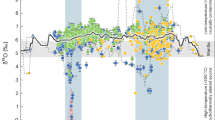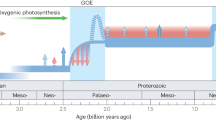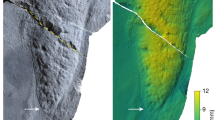Abstract
MANY well-preserved dinoflagellate fossils occur in Jurassic and Cretaceous marine sedimentary sections of various lithologic characteristics in the western North Atlantic and the western side of the Sacramento Valley of California1,2. We have discovered five species which are common to the two sections—las first noticed by W. R. Evitt—each occurring in the Cretaceous above the Cretaceous/Jurassic boundary, and not in the subjacent Jurassic (Fig. 1). These species are Biorbifera johnewingi Habib, Dingodinium cerviculum Cookson and Eisenack, Scriniodinium attadalense Cookson and Eisenack, and two as yet unnamed species, Polysphaeridium sp. and Pyxidiella sp. Two of the five species, B. johnewingi and Polysphaeridium sp., were found to range through most of the Berriasian (lowermost stage of the Cretaceous System) at its type locality in southern France. B. johnewingi satisfies the requirements of a stratigraphically useful guide fossil especially well; it is morphologically distinctive, geographically widespread, relatively abundant in the three areas of investigation, and of limited stratigraphic range (Berriasian-middle Valanginian). Furthermore, it first appears very near the Cretaceous/Jurassic boundary at the three localities. A sixth species, Occisucysta? sp., appears to be discordant, being confined to the uppermost Jurassic in California and the lowermost Cretaceous in the North Atlantic.
This is a preview of subscription content, access via your institution
Access options
Subscribe to this journal
Receive 51 print issues and online access
$199.00 per year
only $3.90 per issue
Buy this article
- Purchase on Springer Link
- Instant access to full article PDF
Prices may be subject to local taxes which are calculated during checkout
Similar content being viewed by others
References
Hollister, C., Ewing, J., Hathaway, J., Lancelot, Y., Habib, D., Poag, C. W., Luterbacher, H. P., Worstell, P., and Wilcoxon, J. A., Initial Reports of the Deep Sea Drilling Project, 11 (US Government Printing Office, Washington, 1972).
Warren, J. S., thesis, Stanford University (1967).
Habib, D., Initial Reports of the Deep Sea Drilling Project (US Government Printing Office, Washington, 1972).
Luterbacher, H. P., Initial Reports of the Deep Sea Drilling Project (US Government Printing Office, Washington, 1972).
Bailey, E. H., Irwin, W. P., and Jones, D. L., Calif. Div. Mines Geol. Bull., 183 (1964).
Jones, D. L., Bailey, E. H., and Imlay, R. W., US Geol. Survey, Prof. Paper 647-a, A1 (1969).
Imlay, R. W., and Jones, D. L., US Geol. Survey, Prof. Paper 647-b, B1 (1970).
Cookson, I. C., and Eisenack, A., Palaeontology, 2, 250 (1960).
Author information
Authors and Affiliations
Rights and permissions
About this article
Cite this article
HABIB, D., WARREN, J. Dinoflagellates near the Cretaceous Jurassic Boundary. Nature 241, 217–218 (1973). https://doi.org/10.1038/241217a0
Received:
Published:
Issue Date:
DOI: https://doi.org/10.1038/241217a0
This article is cited by
-
von Willebrand Factor—Cleaving Protease and Upshaw-Schulman Syndrome
International Journal of Hematology (2002)
-
Venous invasion as a prognostic factor in colorectal cancer
Surgery Today (1995)
-
Immunohistochemical localization of vascular endothelial cell factor viii/von Willebrand factor antigen in human normal and disordered gastric tissues
Journal of Tongji Medical University (1989)
-
An immunohistochemical and electron microscopic study of a central venous hemangioma of the mandible
Archives of Oto-Rhino-Laryngology (1987)
-
Naturally Occurring Canine Nephrotic Syndrome is a Potentially Hypercoagulable State
Acta Veterinaria Scandinavica (1986)
Comments
By submitting a comment you agree to abide by our Terms and Community Guidelines. If you find something abusive or that does not comply with our terms or guidelines please flag it as inappropriate.



